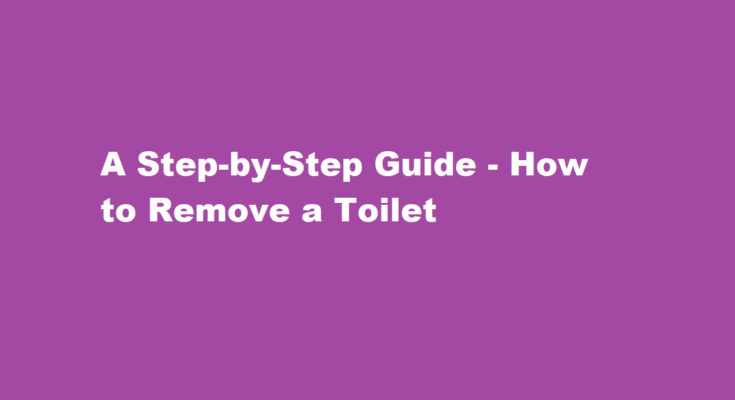Introduction
The toilet is an essential fixture in any bathroom, but there may come a time when you need to replace it or perform repairs. Removing a toilet may seem like a daunting task, but with the right tools and a systematic approach, it can be a relatively straightforward DIY project. In this guide, we’ll walk you through the step-by-step process of how to remove a toilet safely and efficiently.
Tools and Materials You’ll Need
Before you start, gather the necessary tools and materials to make the job easier
1. Adjustable wrench
2. Screwdriver (flathead and Phillips)
3. Bucket or towels
4. Plunger
5. Putty knife or scraper
6. Wax ring and new toilet bolts (if you plan to reinstall the toilet)
7. Rags or paper towels
8. Channel locks or water pump pliers (optional)
Turn Off the Water Supply
Locate the shut-off valve behind or beneath the toilet and turn it clockwise to shut off the water supply. Flush the toilet to empty the tank and the bowl. Use a plunger to remove any remaining water in the bowl or a towel and bucket to soak it up.
Disconnect the Water Supply Line
Use an adjustable wrench to disconnect the water supply line from the fill valve located at the bottom of the tank. Be prepared for a small amount of water to come out during this step, so keep a bucket or towels handy to catch any drips.
Remove the Tank Lid and Flush Mechanism
Lift the tank lid off and place it in a safe location. Inspect the inside of the tank and disconnect any hardware that connects the flush mechanism to the tank. This may include a chain, flapper, or other components. Once disconnected, remove the entire tank from the bowl by loosening the bolts at the base.
Loosen and Remove the Nuts on the Base
Under the base of the toilet, you’ll find two nuts securing it to the floor. Use an adjustable wrench or channel locks to carefully loosen and remove these nuts. If they are rusted or stuck, you may need to apply some penetrating oil and wait for a few minutes to make them easier to remove.
Carefully Lift the Toilet
With the nuts removed, gently lift the toilet bowl straight up from the floor. Be cautious and lift with your legs, not your back, to prevent any injuries. The toilet will be heavy, so it’s a good idea to have a helper if needed.
Scrape Away the Wax Ring
Once the toilet is removed, you’ll likely find a wax ring attached to the flange on the floor. Carefully scrape away the old wax using a putty knife or scraper. Be sure to wear gloves and dispose of the wax ring in a plastic bag.
Plug the Drain Hole
To prevent sewer gases from entering your bathroom, plug the drain hole with a rag or old towel. This will also help keep debris out of the drain during the installation of the new toilet.
Clean and Prepare the Area
With the old toilet removed, take the opportunity to clean the exposed flange and the surrounding floor area. Use warm, soapy water and a disinfectant to thoroughly clean the space. Ensure that there is no residue left from the old wax ring.
Install a New Wax Ring
Before installing your new toilet, you’ll need to replace the old wax ring with a new one. Place the wax ring onto the flange on the floor, ensuring it’s centred and ready to receive the toilet.
Install the New Toilet
Carefully position the new toilet bowl over the wax ring and flange. Gently press down to compress the wax ring and create a secure seal. Align the mounting bolts on the flange with the holes in the base of the toilet bowl. Carefully tighten the nuts on the bolts, ensuring the toilet is level and stable.
Reattach the Tank
If you’re using a two-piece toilet, follow the manufacturer’s instructions to reattach the tank to the bowl. Reconnect the hardware and adjust the water supply line, making sure it’s secure but not overtightened.
Reconnect the Water Supply Line
Reconnect the water supply line to the fill valve and turn on the water supply. Check for any leaks around the base of the toilet and at the water supply connection. If you notice any leaks, tighten the connections further.
Test the Toilet
Flush the toilet and observe its operation. Ensure that it flushes properly, refills, and doesn’t leak water onto the floor. If everything is working as it should, your toilet removal and replacement project is complete.
FREQUENTLY ASKED QUESTIONS
Is it expensive to remove a toilet?
Unless you’re working with new construction, you’ll need to remove your old toilet before installing the new one. Toilet removal and disposal usually costs $100 to $200, though it will be slightly more if you’re removing a wall-hung commode.
Do you need a plumber to remove a toilet?
(Removing a toilet is even easier.) After all, like virtually every other thing in your house, toilets have a lifespan. Of course, you can always call in a professional plumber or handyman to do the job, but this DIY plumbing job is actually pretty simple and a bathroom repair you can do on your own.
Conclusion
Removing a toilet may seem like a challenging task, but by following these step-by-step instructions and taking your time, it can be a manageable DIY project. Whether you’re replacing an old toilet with a new one or making repairs, knowing how to remove and reinstall a toilet can save you money and provide a sense of accomplishment. Just remember to exercise caution, wear protective gear, and follow safety procedures to ensure a successful toilet removal and installation process.
Read Also : Updating Zoom – A Step-by-Step Guide to Ensure Smooth Video Conferencing



